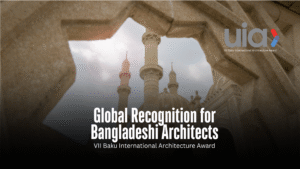Award

Machan and Floating Schools Win Prestigious Ammodo Architecture Award 2025
Two Projects from Bangladesh – Machan: Korail Community Platform in Dhaka by Paraa and the Floating Schools for Community Resilience by Shidhulai Swanirvar Sangstha in Pabna district, —have been named among the 26 global recipients of the 2025 Ammodo Architecture Award for their contributions to socially and ecologically responsible design. From the Ammodo, this year’s selection spans six regions: Africa, Asia, Europe, North & Central America, South America, and Southeast Asia & Oceania. The chosen projects address diverse urban and rural contexts, tackling issues such as housing, education, ecological restoration, and collective living. Awardees were selected by an international advisory committee consisting of six renowned architects and cultural professionals from around the globe: Joumana El Zein Khoury, Andrés Jaque, Anupama Kundoo, Floris Alkemade, Mariam Issoufou and Loreta Castro Reguera. Machan: Korail Community Platform, Dhaka The name – Machan, meaning ‘platform’ in Bangla, is Dhaka’s first community-driven permanent cultural and creative hub located in the Korail low-income settlement. It emerged from the “Korail: City of Culture” initiative, a sustainable urban development project led by architecture studio Paraa. Built collaboratively with Korail residents, youth groups, and community leaders, Machan transforms a former dumping ground into a vibrant cultural centre. The platform hosts a variety of social, cultural, and creative activities including: architectural design exhibitions, artwork displays, photography showcases, installation art, and performing arts. The platform collaborates with other organizations facilitating workshops on participatory planning, community mapping, and arts like indigo dyeing. The project establishes a much-needed, multifunctional open space that enables residents to gather, and participate in shared activities, effectively converting a former waste ground into a dynamic community hub. The project supports local cultural practitioners and connects their knowledge to global discussions on sustainability and the rights of marginalized communities. Floating Schools for Community Resilience by Shidhulai Swanirvar Sangstha, Pabna The “Floating Schools for Community Resilience” project by Shidhulai Swanirvar Sangstha primarily operates along the Gumani River in the Faridpur and Bhangura subdistricts of Pabna. The initiative brings schools to students in villages along the Gumani River, using a flexible fleet of boats for classrooms, health clinics, and training centers to ensure continuity of services during seasonal flooding. The floating schools lead consistent access to education. The initiative eliminates the need for students to travel to schools that may be inaccessible due to flooding, ensuring continued learning. The boats use solar energy to power onboard computers and other equipment, allowing for interactive learning. The boats can also be used as shelters during severe floods, ensuring continuous community support. Due to this initiative, over 22,500 students have graduated from the program so far, and it provides access to education for children who would otherwise have dropped out due to floods or economic hardship. The initiative ensures access to healthcare and training, even during crises, and has been replicated in other countries. The project has empowered women and girls through microloans and income-generating opportunities. The Ammodo Architecture Awards is an annual international prize presented to “advance socially and ecologically responsible architecture worldwide.” The Ammodo Architecture Awards was launched in 2024 by Stichting Ammodo, a Dutch foundation that supports art, science and architecture. The awards aim to “recognize and support architects and projects that address contemporary social and environmental challenges through innovative design and community engagement. Each recipient of Ammodo Architecture Award 2025 receives a grant to further develop their work. The complete list of 2025 awardees can be viewed on the Ammodo Architecture Award website. Written by Tasmiah Chowdhury photo courtesy: City Syntax, Shidhulai Swanirvar Sangstha
Read More
Global Recognition for Bangladeshi Architects
Bangladeshi architects have once again demonstrated their creative strength on the global stage, securing multiple honours at the prestigious VII Baku International Architecture Award. Organised by the Ministry of Culture of the Republic of Azerbaijan and the Union of Architects of Azerbaijan, with the endorsement of the International Union of Architects (UIA), the biennial competition has become a landmark event in the architectural calendar. This year’s edition attracted 270 applications from 38 countries, underscoring its reputation as a truly international platform for design excellence. The award is open to all qualified architects worldwide, offering opportunities for recognition across diverse categories. Against this competitive backdrop, five projects from Bangladesh stood out, earning accolades that highlight the country’s growing influence in contemporary architecture. BANGLADESHI WINNERS ACROSS CATEGORIES In Category B – Best Implemented Project of Residential Architecture, Architect Zishan Fuad Chowdhury won second prize for Neer – Vacation House, a project that blends modern design with contextual sensitivity. In the same category, Architect Mohammad Masud secured third prize for Meghrod – Sun and Cloud, a residential concept that celebrates light and openness. Bangladeshi architects also excelled in Category C – Best Implemented Interior. The Coca-Cola Office Interior by Architect Sharif Uddin Ahammed won second prize, recognised for its innovative approach to workplace design. Architect Shams Sanjida earned third prize in the same category for the Mak Design House, a project praised for its aesthetic coherence and functional elegance. In Category D – Best Non-Realised Project, Architect Sarawat Iqbal won second prize for Masjid Al Luqman, a design that reimagines sacred space with contemporary architectural language. These achievements reflect the breadth of Bangladeshi talent, spanning residential, interior, and conceptual design. STRUCTURE OF THE AWARDS The competition is divided into seven categories: A – Best implemented project of public architecture B – Best implemented project of residential architecture C – Best implemented interiors D – Best non-realised project E – Best implemented project in landscape architecture F – Best implemented project in rehabilitation and reconstruction of historic buildings G – Best publication in the field of architecture Each category recognises excellence in both realised and conceptual projects, ensuring that innovation at every stage of design is celebrated. PRIZES AND RECOGNITION The awards carry significant recognition and financial rewards. First prize winners receive 4,000 AZN (€2,240), a first-degree diploma, and a symbolic cup. Second prize winners are awarded 2,500 AZN (€1,400) and a second-degree diploma, while third prize winners receive 1,000 AZN (~€560) and a third-degree diploma. Beyond monetary value, the awards provide international visibility, positioning winners within a global network of architects and institutions. JURY AND CEREMONY The jury for the 2025 edition comprised distinguished architects from around the world: • Antonio Riverso (Italy), Professor, International Academy of Architecture • Michel Barmaki (Lebanon), Chairman of Barka Sarl • Nikos Fintikakis (Greece), UIA Jury Representative • Young-Keun Han (South Korea), President of the Korean Institute of Architects • Elbay Gasim-zada (Azerbaijan), Representative of the Organisers The results were announced at a ceremony on October 2 this year at the Four Seasons Hotel in Baku, Azerbaijan. The event reinforced Baku’s role as a hub for architectural dialogue, bringing together professionals from across continents. LEGACY AND GLOBAL REACH Since its inception in 2013, the Baku International Architecture Award has attracted architects from 53 countries, with more than 1,200 projects submitted between 2013 and 2023. Winners have hailed from Portugal, France, USA, Slovenia, Georgia, Japan, Russia, Morocco, Croatia, Italy, Bangladesh, Spain, Ukraine, Germany, Vietnam, Singapore, Kyrgyzstan, Greece, Malaysia, South Africa, Egypt, China, Iran, Kenya, UAE, Mexico, Romania, Poland, India, Brazil, and Azerbaijan. A unique tradition of the award is the symbolic gesture of sending a cup identical to that awarded to first-prize winners to France, where it is safeguarded at the headquarters of the International Union of Architects. This act underscores the award’s international spirit and its commitment to architectural heritage. Written by Nibir Ayaan
Read More
Cubeinside Design bags DNA Paris Design Awards 2025
Cubeinside Design Ltd, a prominent Bangladeshi architectural and interior design firm, has earned international acclaim after being named one of the winners at the DNA Paris Design Awards 2025—an internationally sought-after recognition for architects and creative people. The award-winning project, Bait Ur Rayyan, is a small-scale mosque designed by Cubeinside, located near the banks of the mighty Arial Kha River in Bangladesh’s Madaripur. The Bangladeshi firm was the consultant for the project, built for the Rokeya Feroza Foundation on a land area of 7,346 square metres. Cubeinside says: “This particular design is an exercise of abstract interpretation of basic symbolism of Islamic architecture. Geometry has been the principal tool for this abstraction in terms of transforming both the form and spatial quality.” The DNA Paris listed Khandaker Ashifuzzaman and Shakhawat Hossain Rocky as the lead designers of Bait Ur Rayyan, which won the award in the Public Architecture category. The annual awards also mentioned Mehri Farnaz, Anis Khan Shanto and Abdullah Al Jaber as members of the mosque’s design team. About the mosque, it was noted on the DNA Paris website: “A human-centric approach created a space for community, keeping the scale sacred yet intimate, using local materials like red bricks, while lights played the most vital role to uplift the spiritual entity of this mosque.” “The concept of ‘Abstract Semiotics’ was applied in measurable mass and space, and other immeasurable aspects with a deeper perceptual level.” DNA Paris, which celebrates the best in global design from over 70 countries, recognises excellence in Architecture, Landscape, Interior, Product and Graphic Design, with entries divided into ‘Professional’ and ‘Emerging’ categories. The latter is reserved for outstanding student work. Farmani Group, a global authority in architecture, design and photography curation, in partnership with In Between, a Paris-based collective of creatives and thinkers, jointly organise the DNA Paris Design Awards. In addition to typology-based subcategories, the most distinguished entries across all five disciplines and both sections are awarded the Grand Prix—the highest honour of the programme. Recipients of the Grand Prix receive a trophy created by Studio Briand & Berthereau, designed to strike a balance between form and function, while addressing the financial and environmental constraints faced by every project. All submissions are evaluated by an expert jury of design luminaries. The jury committee is comprised of designers, editors and creatives who are devoted to true excellence in design. The juries come from different countries, including the UK, the USA, Spain, Argentina, Japan, Sweden, France, Kenya, Thailand, Brazil, Italy, South Korea, Hong Kong, Mexico, Greece and Saudi Arabia. The evaluation of entries is based on a range of criteria that are constantly adapted to current standards. DNA Paris has already announced all winners across different categories for this year, who will be honoured at an event in Paris on October 24. Written by Nibir Ayaan
Read More
